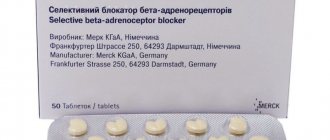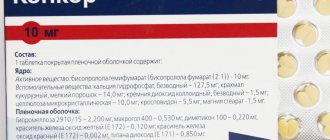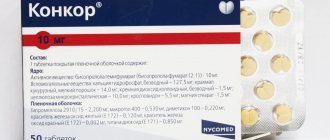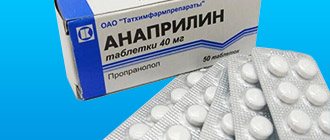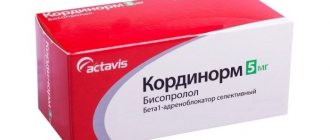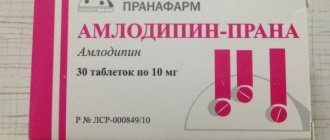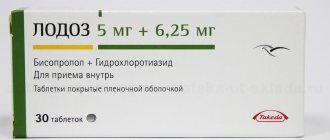In the treatment of arterial hypertension (AH), both single-component and combined drugs are used that affect physiological mechanisms in the heart and blood vessels. Combination antihypertensive drugs include Concor AM; it is considered a fairly effective drug with a convenient dosage.
The medicine is well tolerated by patients (according to reviews), and receives positive recommendations from therapists and cardiologists due to the presence of combinations of two active components in the composition.
Composition of the drug
The drug contains a selective beta1-blocker bisoprolol and a calcium channel blocker amlodipine. The drug is available in four combinations of active components:
- 5 mg bisoprolol / 5 mg amlodipine;
- 5 mg bisoprolol / 10 mg amlodipine;
- 10 mg bisiprolol / 5 mg amlodipine;
- 10 mg bisoprolol / 10 mg amlodipine.
Various combinations of components allow the attending physician to choose the optimal dosage option for the drug. It is possible to accurately select the combination during the patient’s previous treatment with single-component drugs.
At the beginning of antihypertensive therapy, the doctor selects drugs from different pharmacological groups, observing the reaction. Based on the dynamics of blood pressure (BP), the body’s sensitivity to the active ingredients and on the basis of examinations, the doctor can adjust the dosage and prescribe additional drugs for maximum therapeutic effect with a minimum of side effects.
The combination of amlodipine and bisoprolol in one drug allows the doctor and patient to simplify the way they take medications. In the form of Concor AM, instead of two drugs, you need to take one, which has a more pronounced therapeutic effect.
Release form and composition
The dosage form of Concor is tablets: biconvex, film-coated, pale yellow or pale orange, heart-shaped (10, 25 or 30 tablets per blister, 1, 2, 3 or 5 blisters in a cardboard box).
Active substance – bisoprolol hemifumarate (bisoprolol fumarate (2:1)), content in 1 tablet, depending on the color of the shell:
- Pale yellow – 5 mg;
- Pale orange – 10 mg.
Additional components: fine corn starch powder, anhydrous colloidal silicon dioxide, microcrystalline cellulose (MCC), anhydrous calcium hydrogen phosphate, magnesium stearate, crospovidone.
Film shell composition: hypromellose, dimethicone 100, yellow iron oxide dye (E172), macrogol 400, titanium dioxide (E171), red iron oxide dye (E172).
What is the difference between Concor and Concor AM?
Concor is a single-component antihypertensive drug that contains only one active substance - bisoprolol fumarate. There is no second active substance in the medicine. This is the only way Concor differs from Concor AM. In the second drug, a selective beta-blocker is combined with a calcium channel blocker, amlodipine. Concor's nosological list (which drugs help with) includes not only hypertension. The drug is prescribed for coronary heart disease (CHD), angina pectoris, and congestive heart failure. Concor AM has a more limited list of diseases that can be corrected with this drug.
Side effects
May cause worsening of chronic heart failure and bradycardia. Taking the drug may be accompanied by a decrease in blood pressure, AV conduction disturbances, headaches, insomnia, loss of consciousness, nightmares, hearing loss, hallucinations, dizziness, depression, decreased tear production, and conjunctivitis.
In patients with bronchial asthma and obstructive airway diseases that have been observed in the patient in the past, the drug may cause bronchospasms.
Side effects observed as a result of taking Concor include nausea, diarrhea, decreased potency, constipation, increased levels of liver enzymes, hepatitis, allergic skin reactions, muscle cramps, exacerbation of psoriasis, alopecia, asthenia and fatigue.
What is it used for?
The drug is intended for the correction of hypertension, primary and secondary. The drug can be taken only on the recommendation of the attending physician based on examination of the patient. The specialist must conduct a physical examination, perform an electrocardiogram and ultrasound of the heart (if necessary), examine the structure of the fundus (it is damaged by hypertension).
The final diagnosis is based on measuring blood pressure over time. If the indicators are consistently exceeded 140/90 mmHg. Art. A diagnosis of arterial hypertension is made.
The doctor is faced with a choice between different groups of drugs that have a hypotensive effect by influencing the mechanisms that cause an increase in blood pressure. The choice of active substance is based on the patient’s health status and is selected in such a way as to obtain the maximum therapeutic effect and minimize side effects.
The drug contains a selective beta-blocker and a calcium channel blocker (CCB).
A beta-blocker inhibits the reaction of beta-adrenergic receptors to the action of the adrenal hormones adrenaline and norepinephrine, under the influence of which inotropic reactions occur. Bisoprolol, suppressing beta-adrenergic receptors, acts as follows:
- slows down the pulse (HR);
- reduces the conductivity of the heart muscle;
- reduces myocardial contractility;
- reduces the heart's need for oxygen;
A calcium channel blocker is a drug that selectively stops the flow of calcium ions into cells through the “slow” L-type channels. CCB has a negative inotropic and vasodilating effect. Amlodipine produces the following effects:
- affects the transmembrane entry of calcium ions into cardiomyocytes during excitation, reducing the breakdown of adenosine triphosphate (ATP);
- reduces the force of contraction and the heart’s need for oxygen;
- reduces vascular tone, preventing vasospasm;
- reduces afterload on the heart;
- increases blood flow in ischemic areas of the heart;
- slows down the appearance of atherosclerotic plaques.
CCB has a different mechanism of action on the heart and blood vessels; it produces a pronounced hypotensive effect. In combination, a CCB and a beta-blocker help to effectively reduce blood pressure and keep it within normal limits due to a synergistic effect. The drugs complement each other, exerting a selective effect on the mechanisms that cause an increase in blood pressure. There are no other side effects associated with negative inotropic and vasodilating effects.
Consequences of arterial hypertension for the human body
Drug interactions
Amlodipine
The simultaneous use of amlodipine with thiazide diuretics, beta-blockers, long-acting nitrates, sublingual nitroglycerin preparations, NSAIDs, antibiotics and oral hypoglycemic agents is considered safe.
CYP3A4 inhibitors: Amlodipine should be used with caution concomitantly with CYP3A4 inhibitors.
Strong and moderate inhibitors of CYP3A4 (for example, protease inhibitors, azole antifungals, macrolides such as erythromycin or clarithromycin, verapamil or diltiazem) may increase plasma concentrations of amlodipine to clinically significant levels.
CYP3A4 inducers: simultaneous use with CYP3A4 inducers (including rifampicin, St. John's wort) may lead to a decrease in the concentration of amlodipine in the blood plasma. Amlodipine should be used with caution concomitantly with CYP3A4 inducers.
Simvastatin: simultaneous use with amlodipine may lead to an increase in the concentration of simvastatin in the blood plasma. Patients taking amlodipine are not recommended to use simvastatin at a dose exceeding 20 mg/day.
Grapefruit juice, cimetidine, aluminum/magnesium (as part of antacids) and sildenafil do not affect the pharmacokinetics of amlodipine.
Amlodipine may enhance the antihypertensive effect of other antihypertensive drugs.
Amlodipine does not affect the pharmacokinetics of atorvastatin, digoxin, ethanol (drinks containing alcohol), warfarin or cyclosporine.
Amlodipine has no effect on laboratory parameters.
Bisoprolol
Combinations not recommended
BMCCs such as verapamil and, to a lesser extent, diltiazem, when used simultaneously with bisoprolol, can lead to a decrease in myocardial contractility, a pronounced decrease in blood pressure and impaired AV conduction. In particular, intravenous administration of verapamil to patients taking beta-blockers can lead to severe arterial hypotension and AV blockade.
Centrally acting antihypertensives (such as clonidine, methyldopa, moxonidine, rilmenidine), when used simultaneously with bisoprolol, can lead to a decrease in heart rate and a decrease in cardiac output, as well as vasodilation due to a decrease in central sympathetic tone. Abrupt withdrawal, especially before discontinuation of beta-blockers, may increase the risk of developing rebound hypertension.
Combinations requiring caution
BMCC dihydropyridine derivatives (for example, nifedipine), when used simultaneously with bisoprolol, may increase the risk of developing arterial hypotension. In patients with chronic heart failure, the risk of subsequent deterioration of cardiac contractile function cannot be excluded.
Class I antiarrhythmic drugs (for example, quinidine, disopyramide, lidocaine, phenytoin, flecainide, propafenone), when used simultaneously with bisoprolol, can reduce AV conductivity and myocardial contractility.
Class III antiarrhythmic drugs (eg, amiodarone) may worsen AV conduction disturbances.
Parasympathomimetics, when used simultaneously with bisoprolol, may increase AV conduction disturbances and increase the risk of bradycardia.
The effect of beta-blockers for topical use (for example, eye drops for the treatment of glaucoma) may enhance the systemic effects of bisoprolol (lowering blood pressure, lowering heart rate).
The hypoglycemic effect of insulin or oral hypoglycemic agents may be enhanced. Signs of hypoglycemia - in particular tachycardia - may be masked. Such interactions are more likely when using non-selective beta-blockers.
General anesthesia agents may attenuate reflex tachycardia and increase the risk of developing arterial hypotension.
Cardiac glycosides, when used simultaneously with bisoprolol, can lead to an increase in impulse conduction time and the development of bradycardia.
NSAIDs may reduce the antihypertensive effect of bisoprolol.
The simultaneous use of bisoprolol with beta-agonists (for example, isoprenaline, dobutamine) may lead to a decrease in the effect of both drugs.
The combination of bisoprolol with adrenergic agonists that affect α- and β-adrenergic receptors (for example, norepinephrine, epinephrine) may enhance the vasoconstrictor effects of these drugs that occur with the participation of α-adrenergic receptors, leading to an increase in blood pressure. Such interactions are more likely when using non-selective beta-blockers.
Antihypertensive drugs, as well as other drugs with a possible antihypertensive effect (for example, tricyclic antidepressants, barbiturates, phenothiazines) may enhance the antihypertensive effect of bisoprolol.
Combinations to consider
Mefloquine, when used simultaneously with bisoprolol, may increase the risk of bradycardia.
MAO inhibitors (except MAO B inhibitors) may enhance the antihypertensive effect of beta-blockers. Concomitant use may also lead to the development of a hypertensive crisis.
Rifampicin slightly shortens the T1/2 of bisoprolol. As a rule, no dose adjustment is required.
Ergotamine derivatives, when used simultaneously with bisoprolol, increase the risk of developing peripheral circulatory disorders.
Instructions for use
The instructions for use recommend taking the drug Concor AM in the dosage form selected by the doctor. The specialist prescribes medicine based on an examination of blood pressure dynamics and general health. The reception scheme is simple:
- one tablet of the drug once a day;
- reception time - morning;
- You can take the tablet both before and after meals.
Concor is usually taken for a long time as maintenance therapy.
Indications
Indications for taking Concor AM are obvious, both according to the instructions for use and the pharmacological group of both components in the drug. The drug is listed as an antihypertensive drug and should be taken if hypertension is diagnosed.
Important! You should not prescribe medication yourself if symptoms of hypertension appear. Even if there is a family history of hypertension, and the medicine helps friends, acquaintances or relatives, this is not a reason to take drugs.
Only a doctor should choose the medicine, dosage, and duration of the course. When taken independently, the patient has no guarantee that the drug will give the desired therapeutic effect without side effects.
How to use?
If before taking Concor the patient was taking single-component drugs for the treatment of hypertension - a selective beta-blocker or a calcium channel antagonist, then you can start taking the medication without interruption, at the dosage prescribed by the doctor.
If there is no effect, or if the hypotensive effect is not sufficiently pronounced, it is not recommended to increase the dosage on your own. You need to consult a doctor.
Dosage
The minimum dosage of the drug corresponds to Concor AM 5/5. At the initial stage of antihypertensive therapy, 5 mg of bisoprolol and 5 mg of amlodipine are sufficient to determine the body's response to the active substances. If the therapeutic effect is sufficient, then the doctor can transfer the patient to Concor AM 5/10 1–2 weeks after the start of treatment. If the antihypertensive effect is insufficient, the patient is transferred to Concor AM 10/10.
special instructions
There are several groups of patients who are prescribed selective beta-blockers and calcium channel blockers with increased caution. If it is necessary to use these groups of drugs, the minimum dosage is selected.
- Patients with functional liver diseases should take no more than 5 mg of amlodipine per day, since it is eliminated from the body more slowly. The dose of bisoprolol should be no more than 10 mg. The optimal form of the drug in this case is Concor AM 5/5 or Concor AM 5/10.
- Patients with impaired renal function should take Concor AM with caution. In this case, the maximum dosage of bisoprolol does not exceed 10 mg per day. Concor AM 5/10 and Concor 10/10 are allowed. For patients undergoing dialysis, a minimum dosage of amlodipine is recommended.
Having started therapy with Concor, it is not recommended to abruptly stop it due to the high likelihood of worsening the clinical condition of hypertension.
Concor AM
Combined antihypertensive drug. It has pronounced antihypertensive and antianginal effects due to the complementary action of two active substances: a slow calcium channel blocker (SCBC) - amlodipine and a selective beta1-blocker - bisoprolol.
Amlodipine
Amlodipine blocks calcium channels, reduces the transmembrane transition of calcium ions into the cell (more into vascular smooth muscle cells than into cardiomyocytes).
The antihypertensive effect of amlodipine is due to a direct relaxing effect on vascular smooth muscle cells, which leads to a decrease in peripheral vascular resistance.
The mechanism of antianginal action is not fully understood; it may be associated with the following two effects.
1. The expansion of peripheral arterioles reduces peripheral vascular resistance, i.e. afterload. Since amlodipine does not cause reflex tachycardia, myocardial energy and oxygen consumption is reduced.
2. Dilatation of large coronary arteries and coronary arterioles improves oxygen supply to both normal and ischemic areas of the myocardium. Thanks to these effects, the supply of oxygen to the myocardium is improved, even with spasm of the coronary arteries (Prinzmetal's angina or unstable angina).
In patients with arterial hypertension, taking the drug once a day causes a clinically significant decrease in blood pressure in the supine and standing positions throughout the entire 24-hour interval between doses of the drug. Due to the slow development of the antihypertensive effect of amlodipine, it does not cause acute arterial hypotension.
In patients with angina pectoris, taking the drug once a day increases the total time of physical activity, the time before the development of an angina attack, as well as the time until a significant decrease in the ST interval, and also reduces the frequency of angina attacks and the need for sublingual nitroglycerin.
No negative effect of amlodipine on the metabolism of plasma lipids, blood glucose and serum uric acid was detected.
Bisoprolol
Bisoprolol is a selective beta1-blocker, without its own sympathomimetic activity, and does not have a membrane-stabilizing effect.
It has only slight affinity for c2-adrenergic receptors of the smooth muscles of the bronchi and blood vessels, as well as for β2-adrenergic receptors involved in the regulation of metabolism. Therefore, bisoprolol generally does not affect airway resistance and metabolic processes in which β2-adrenergic receptors are involved.
The selective effect of the drug on β1-adrenergic receptors persists beyond the therapeutic range.
Bisoprolol does not have a pronounced negative inotropic effect.
The maximum effect of the drug is achieved 3-4 hours after oral administration. Even when bisoprolol is prescribed once a day, its therapeutic effect persists for 24 hours due to 10-12 hours T1/2 from blood plasma. As a rule, the maximum antihypertensive effect is achieved 2 weeks after the start of treatment.
Bisoprolol reduces the activity of the sympathoadrenal system (SAS) by blocking β1-adrenergic receptors of the heart.
When administered once orally in patients with coronary artery disease without signs of chronic heart failure, bisoprolol reduces heart rate, reduces the stroke volume of the heart and, as a result, reduces the ejection fraction and myocardial oxygen demand. With long-term therapy, the initially elevated TPR decreases. A decrease in renin activity in blood plasma is considered as one of the components of the hypotensive effect of beta-blockers.
Pharmacokinetics
Amlodipine
Suction
Amlodipine is well absorbed after oral administration. Cmax in blood plasma is observed after 6-12 hours. Taking the drug with food does not affect its absorption. Absolute bioavailability is 64-80%.
Distribution
Apparent Vd is 21 l/kg. Css in blood plasma (5-15 ng/ml) is achieved 7-8 days after starting the drug.
In vitro studies have shown that circulating amlodipine is approximately 93-98% bound to plasma proteins.
Metabolism and excretion
Amlodipine undergoes extensive metabolism in the liver. Approximately 90% of the dose taken is converted into inactive pyridine derivatives. Approximately 10% of the dose taken is excreted unchanged in the urine. Approximately 60% of the amount of inactive metabolites is excreted by the kidneys and 20-25% through the intestines. The decrease in plasma concentration is biphasic. The final T1/2 is approximately 35-50 hours, which allows the drug to be administered once a day. The total clearance is 7 ml/min/kg (25 l/h in a patient weighing 60 kg). In elderly patients it is 19 l/h.
Pharmacokinetics in special clinical situations
In elderly patients and patients with renal failure, no significant changes in the pharmacokinetics of amlodipine were observed.
Due to decreased clearance, patients with hepatic impairment should be given lower initial doses.
Bisoprolol
Suction
Bisoprolol is almost completely (more than 90%) absorbed from the gastrointestinal tract. Its bioavailability due to low first-pass metabolism through the liver (at approximately 10%) is approximately 90% after oral administration. Food intake does not affect bioavailability. Bisoprolol exhibits linear kinetics, with its plasma concentrations being proportional to the dose taken in the range from 5 to 20 mg. Cmax in blood plasma is achieved after 2-3 hours.
Distribution
Bisoprolol is distributed quite widely. Vd is 3.5 l/kg. Plasma protein binding reaches approximately 30%.
Metabolism
Metabolized via the oxidative pathway without subsequent conjugation. All metabolites are polar (water-soluble) and are excreted by the kidneys. The main metabolites found in blood plasma and urine do not exhibit pharmacological activity. Data obtained from experiments with human liver microsomes in vitro show that bisoprolol is metabolized primarily by the CYP3A4 isoenzyme (about 95%), and the CYP2D6 isoenzyme plays only a minor role.
Removal
The clearance of bisoprolol is determined by the balance between excretion by the kidneys unchanged (about 50%) and metabolism in the liver (about 50%) to metabolites, which are also excreted by the kidneys. The total clearance is 15 l/h. T1/2 -10-12 hours.
Side effects
While taking Concor, side effects may occur that may be associated with the action of bisoprolol and amlodipine separately. Both substances equally often have the following side effects:
- headache, dizziness, asthenia;
- slow heartbeat;
- severe decrease in blood pressure;
- dyspeptic symptoms (nausea, heartburn);
- allergic reactions to the drug.
Bisoprolol may be associated with a decrease in tear production and discomfort when using contact lenses. Amlodipine may have an effect on the central nervous system and cause sleep disturbances, depression, anxiety and increased excitability.
Possible adverse reactions
Side effects from therapy may appear only at the initial stage of treatment with the drug, and after half a month the condition returns to normal. The patient may be concerned about:
- the presence of an allergic reaction in the form of a rash;
- mental disorders in the form of sleep disturbances, anxiety and anxiety;
- dizziness, headaches, increased muscle tone;
- blurred vision;
- tinnitus;
- nausea, vomiting, gastritis or pancreatitis;
- hepatitis and jaundice;
- leukopenia;
- arrhythmia, bradycardia, tachycardia;
- cough, shortness of breath, rhinitis;
- urinary disturbance;
- weakness, malaise, chest pain;
- swelling, muscle cramps, back pain;
- sweating, urticaria on the skin, itching;
- weight loss or weight gain;
- hearing impairment.
If these symptoms are detected, the doctor may stop taking the pills and replace them with others.
Compatibility of the drug with alcohol
People with problems with the heart and blood vessels should drink alcohol in minimal quantities or avoid it altogether. Alcohol tends to constrict blood vessels after temporarily dilating. Despite the fact that the instructions for use do not describe the effect of amlodipine and bisoprolol on the pharmacokinetics of ethanol, it is not recommended to use antihypertensive drugs with alcohol. This can lead to the development of excessive drug exposure in the form of a drop in blood pressure, bradycardia and heart failure.
Video on the topic
Instructions for the drug Concor in the video:
Problems with the heart and blood vessels deserve special attention, since if not properly treated they can be fatal. It is for this reason that when the slightest disturbance appears, you need to contact specialists to conduct a proper examination, take tests and prescribe appropriate therapy.
For most diseases of the heart muscle, arteries, veins and capillaries, the drug Concor is used, which has a wide range of effects. But, nevertheless, you should take it with extreme caution in order to avoid unwanted complications in the functioning of certain organs and systems.
The information on the MyMedNews.ru website is for reference and general information, collected from publicly available sources and cannot serve as a basis for making a decision on the use of medications in the course of treatment.
MyMedNews.ru
And we also have
Review of the cheapest analogues of the drug Noliprel, domestic and foreign production
Contraindications
It is not recommended to take Concor if:
- severe form of arterial hypotension;
- individual sensitivity to the components of the drug;
- aortic stenosis;
- after a heart attack;
- weakness of sinus rhythm.
The effect of Concor on patients of childhood and adolescence has not been sufficiently studied, therefore taking drugs under 18 years of age is prohibited. Drugs are prescribed to pregnant women in cases where the benefit to the mother is greater than the side effect on the fetus. It is prohibited to take drugs while breastfeeding, since CCBs penetrate into mother's milk.
Patient reviews
The German drug Concor produced by Merck KGaA belongs to the drugs of the high price category. Perhaps this is why reviews about Concor AM are rare. Those who have taken the drug rate its effect positively:
- the drug stably reduces blood pressure and keeps it within normal limits throughout the day;
- does not cause a sharp decrease in pressure, the effect develops within 30–40 minutes, producing a hypotensive effect gradually;
- stabilizes heart rate;
- Regarding the duration of the course, reviews note that the drug begins to act quite quickly - after taking the first tablet.
The few negative reviews about Concor AM 5/5 describe side effects associated with amlodipine: swelling of the lower extremities is sometimes observed against its background. The cost of the drug is also considered a disadvantage.

